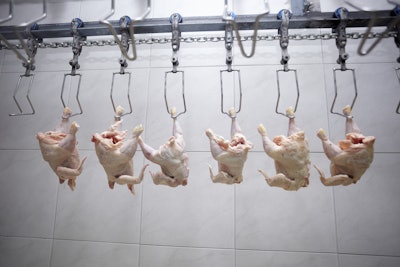
Automation is commonly deemed the solution for labor shortages, one of poultry processing’s biggest challenges. Additionally, it is often recognized for its potential to make operations more efficient, dependable and predictable.
During a panel at the 2022 Poultry Tech Summit in Atlanta, technology’s evolution to meet the needs of poultry processing’s harsh environment was discussed by a group that included Jay Russell, a key account manager at Marel, Mathias Konne, Staubli Robotics' food market leader and Harley Green, business development director Soft Robotics Inc..
Automation in the U.S.
The U.S. poultry market is looking to transition into using more food processing automation. However, it is still reliant on people returning to processing plants, which hindered automation's launch in the industry, Russell said.
Additionally, increased costs due to supply chain issues and the lasting effects of COVID-19 hindered its implementation.
“The workforce has evolved over the last few years, which has pushed the poultry industry to develop more attractive floor plans due to the competitive labor market,” Russell said. “Utilizing more automation will make the industry more attractive to young professionals.”
An additional roadblock the industry is facing is the use of many individual pieces of equipment that are not connected to each other. Finding the process opportunities between production runs and monthly margins can be difficult because individual pieces of equipment create isolated data.
“We're increasing the level of consciousness in the industry by having all equipment linked together to produce actionable data,” Russell said. "An integrated process flow allows you to make real time adjustments in the process for profitability.”
To address this, Russell recommends Marel’s SmartBase technology, which connects machines to each other and delivers real time data to users with access through cloud computing in order to make decisions that will optimize production.
State of the art
The palletizer is the most popular robotic application currently in food processing, and often the first piece of automation used in the process flow, according to Konne. After that, handling technology, such as conveyor transfers or machine loaders, are used, followed by packaging automation.
Robotics must withstand not only cold conditions for processing, but warm conditions during sanitation. During sanitation, many plants use the time, action, chemistry and temperature approach, which involves high levels of pressure and multiple chemicals, Konne said.
“We have to have robots that are able to perform in a humid environment. That’s what has prevented robots from entering the industry for a long time,” Konne said.
The right equipment exists for each plant, producers just need to find the right partners to work with to achieve their goal and ensure success. Konne said a good partner should be a specialist in that area and always be available to provide technical support, even after the sale is completed and well after the technology is installed.
For producers to ensure that they will meet their goals and reduce the amount of labor needed, they need to focus on implementing robotics into parts of the process that rely on volume and speed, require little flexibility and are dirty, dangerous or repetitive jobs.
In the future, Konne said he believes automation should focus on relieving labor in the live hang area, implementing so-called cobots, or collaborative robots, to allow direct human-robot interaction and improving wash down resistance, design and efficiency.
A new solution
COVID-19 caused demand for protein to increase, as well as highlighted the need for solutions to relieve the labor issues that poultry producers are facing.
Soft Robotics focuses on solving one portion of a process that a producer wants to address, while reducing a plant’s footprint, such as the rehang area or implementing palletizing technology, said Green. Expanding the responsibility of one robot will decrease a plant’s footprint.
“Our company focuses on reducing the dependence on human labor. People are flexible and a plant can run flex lines when it utilizes human labor. It is more challenging for robotics to do this because they generally are dedicated to handling certain products on a certain line,” Green said. “What we're trying to do is increase the ability of a single robot to handle different products, similar to a flex line, without the changeover.”
Attend the 2023 Poultry Tech Summit
Join an exclusive international gathering of industry-changing innovators, researchers, entrepreneurs, technology experts, investors and leading poultry producers at the 2023 edition of Poultry Tech Summit on November 6-8 at the Hilton Atlanta Airport in Atlanta, Georgia.
Attendees can expect the same groundbreaking innovation and insightful presentations that made the previous events well-attended with deep dialogue on new prospective solutions and next-generation technologies. Poultry Tech Summit focuses on the transition of innovative technologies into commercial applications to advance the poultry industry.
Registration for this event will open in the spring of 2023.


















